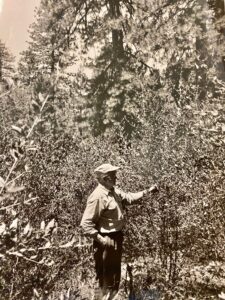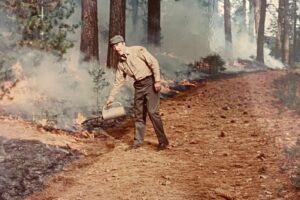
The Harold H. Biswell papers are now open to researchers at the Bancroft Library. Harold H. Biswell (1905-1992) served as a faculty member in the School of Forestry from 1947 to 1973. Biswell was a researcher, teacher, and advocate of the use of prescribed burning for fire management. Prescribed burns are intentionally-set fires for purposes of forest management, fire suppression, farming, prairie restoration or greenhouse gas abatement. The Biswell papers include photographs and slides of controlled burns and survey images of California forests, chaparral, and ranches. The collection also contains articles by Biswell and others, reports, booklets, survey and research material, School of Forestry theses, and other material related to controlled burning and forest ecology.

Indigenous peoples were the first to use cultural burning for managing vegetation and wildlife habitats. “Cultural burning” refers to the Indigenous practice of intentionally setting fires in alignment with traditional belief and knowledge systems to revitalize habitats or provide a desired cultural service, such as promoting the health of vegetation and animals that provide food, clothing, ceremonial items and more. These practices were disrupted by European colonization and forced relocation of Indigenous communities from the lands they had been maintaining for centuries. In 1850, California passed the Act for the Government and Protection of Indians, which outlawed intentional burning. These bans, guided by a strategy of fire suppression, led the way for a rapid increase in destructive wildfires, as well as the inability for Indigenous people to practice traditional cultural burning practices.

Despite opposition and direct criticism, Biswell continually advocated for developing new policies for prescribed burning. Biswell staked his academic reputation on demonstrating that prescribed burns improved ecosystem health and reduced wildfire threats. The Forest Service began to examine its fire exclusion policy in the early 1970’s, and in 1978 the national policy was changed to encompass total fire management including prevention, suppression, and use. Prescribed burns are now recognized as a critical tool to reduce the severity of wildfires.